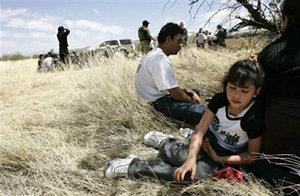 |
 |
 |
 News from Around the Americas | May 2006 News from Around the Americas | May 2006  
Illegal Immigrants Have Kids Smuggled In
 Olga R. Rodriguez - Associated Press Olga R. Rodriguez - Associated Press


| | Gerardo Rivas sits with his Seven-year-old Olga Rivas, right, sits with her father Gerardo Rivas, in white shirt after she and her family were caught crossing illegally into Arizona from Sasabe, Mexico, Tuesday, April 25, 2006. Olga walked through the desert for fourteen hours with her family before being caught by the U.S. Border Patrol. (AP/Gregory Bull) |
Alejandro Valenzuela, a loquacious 12-year-old, memorized the details of a borrowed U.S. birth certificate and jumped in the front seat of his smuggler's car.

Tired from a two-day bus trip to the border from Mexico's central state of Jalisco, Alejandro soon fell asleep. He was awakened by the flashlight of a U.S. immigration inspector.

"I told him in English, 'I'm an American citizen,' but he kept asking questions. That's all the English I know," Alejandro said as he rested at a child welfare office back in Tijuana, across the border from San Diego.

Alejandro is one of a rising number of children trying to sneak into the United States without their parents. Some hide in cars or try to pass themselves off as U.S. citizens, while others ride inner tubes across the Rio Grande or trek through the harsh Arizona desert.

Since October, about 70,000 children have been detained along the Mexican border, a 5 percent increase over the same period a year earlier, the U.S. Border Patrol says.

Like Alejandro — who wants to get to Corona, Calif., to join a father he hasn't seen in nine years — most children are heading north to reunite with parents living illegally in the United States.

The Sept. 11 terror attacks prompted the United States to tighten security along its southern border, making it harder to sneak in. Rather than risking a return to Mexico to get their children, many migrants are paying smugglers to bring them north.

Experts say that number will likely increase if the U.S. Congress presses ahead with plans to tighten border security even more.

In the traditional method of crossing children, a smuggler drives across the border pretending to be a relative of the child, who is carrying false or "borrowed" documents. But border agents are giving closer scrutiny to documents, and smugglers are tyring other methods.

"We're seeing a very dangerous trend of stuffing minors in trunks, in hidden compartments, in washing machines, even in gas tanks," said Adele Fasano, director of field operations for the San Diego district of U.S. Customs and Border Protection.

Her district includes the San Ysidro Port of Entry, the world's busiest border crossing.

Last August, border inspectors found a 10-year-old boy who had been sedated with cough medicine and crammed inside the dashboard of a van. The boy was unconscious and dehydrated, Fasano said.

Other children detained on the California border have been found strapped under car seats, rolled into carpets, hidden in compartments welded under pickup trucks and — in one case — stuffed inside a pinata.

Fasano said many of those children had to be treated for respiratory distress or burns from being near hot engines.

"These are criminals working with sophisticated smuggling organizations that will go to any length to make money," Fasano said. "That parents would turn their children over to these criminals is very distressing."

Migrants pay up to $2,500 to have a child smuggled through an official border crossing into California. The fee is often cut in half for crossings by foot through the hills near Tijuana or Tecate or across the Arizona desert.

Mexican authorities say they are seeing more children smuggled through the Arizona desert, where migrants often endure three days of walking in searing heat during the day and freezing cold at night.

In the first three months of this year, Mexican officials turned back 3,289 minors at border crossings in the state of Sonora, across from Arizona — more than double the 1,566 sent back in the same period last year.

Juan Enrique Mendez, who oversees the Tijuana child welfare office that receives children turned over by U.S. authorities, said his center has handled more than 1,700 youngsters since January, 200 more than in the same period last year.

"A lot of the children arrive in a very delicate emotional state," he said. "When they are caught, they're often scared and ask us if they're now criminals because they have been to prison."

More than half of the minors who attempt to cross through the Tijuana area are between 13 and 17, but the child welfare office also receives an average of five children a month who are younger than 2, Mendez said.

Child migrants are usually accompanied to the border by a parent or a close relative who intends to cross later. Those relatives follow the youngsters' progress from Mexico, and by the time they are caught, anxious mothers or worried uncles have usually already called Mendez's office looking for information.

He said most children are turned over to their families the same day they are repatriated by U.S. authorities. The rest go to a government-run shelter or the YMCA until they are picked up — when they often try to cross again.

Alejandro was waiting for his grandmother to come and take him to a Tijuana hotel, where they would meet another smuggler.

"I want to go to the United States to study and to see my father," Alejandro said. "My father sends me money on my birthday and gifts for Christmas, but what I want is to see him." | 
 | |
 |



